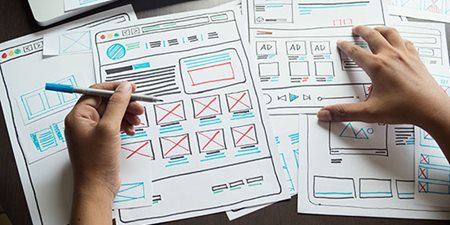The Goods Part 3: Website Design Statistics and Trends
By Lynette Sawyer
April 9, 2019
Design, Digital Marketing, Digital Trends, ecommerce, eCommerce Website Design, mobile marketing, requirements, UI/UX, UI, user experience, UX, web design, web development
In the third of our four-post series, we delve into the report from GoodFirms on website design stats and trends for small businesses. Read up on the other posts in our series:
-
The Goods on SEO Strategies, Techniques, and Trends
-
The Goods on mCommerce and Mobile Apps
Today, users are dependent on online mediums, such as websites and apps, to look for information, products, services, or both. In fact, according to the eCommerce Foundation, 88% of consumers will research product information online before they make a purchase. This buying behavior truly emphasizes the importance of  having a user-focused, well-designed website for your business.
having a user-focused, well-designed website for your business.
Web design, including UI and UX, visualizes a path for users to learn about a business, their brand, their products, and their services. A good website will pass along information and potentially convert a user, but a user-focused, well-designed website visually represents a brand, easily guides a user to their endpoint, and keeps them engaged. Web design encompasses many aspects such as colors, typography, flat or animated design, interactivity, and responsiveness. Web design also demands a wide range of creative and technical skills and many different roles, from architecture, graphical communication, interface configuration and design, smart coding, user experience design, to search engine optimization.
Simply stated, any amazing web presence that easily receives a large volume of traffic, engages users, and converts that traffic to sales is the result of perfect execution of the above parameters. Whether it’s hiring a firm to design your site, or designing your own, we explore GoodFirm’s survey result data to find out more about what trends are apparent in web design today.
8-Point Summary of the Survey
GoodFirms conducted a survey among over 200 web agencies which regularly engage with freelancers, to gauge and understand
-
The client-centric information with reference to hiring web designing experts.
-
The latest designing trends and tools that are effective and efficient.
Required features and functionalities, user interface, and user experience by making the design responsive to multiple devices and browsers are the key parameters that influence the cost of web designing.
-
The average time that is taken to design a website with basic features is two months.
-
The UI/UX tools that are mainly used by proficient web designers is Photoshop, Illustrator, Sketch, and InDesign.
-
Flat design, expressive technology, broken grid layouts, virtual reality video, and voice user-interface and search emerged as the latest trends in web design that have been able to capture the minds of users successfully.
-
The most common web design mistake made by small and medium businesses when designing their business site is over-crowded designing content.
-
Slow loading speed, lack of mobile responsiveness, and bad navigation of a website are the top three reasons for a visitor to leave a business website. Hence, the top three features that are frequently requested by the clients are responsive design, simple and user-friendly navigation, and fast loading speed of the website.
-
If your conversion rate is low and bounce rate is high, be assured that you are in dire need of redesigning your business website.
-
Acquiring a completely customizable website is revealed to be the principal reason for hiring a professional web designer or company rather than using a website building software platform, such as Wix.com or Squarespace.
When surfing the web, you will notice that more websites are moving toward bold design features such as animations and interactive elements, vivacious color palettes, style trends of flat, minimal and 3D, fun illustrations, asymmetric layouts, unique typesets, or multiple styles that offer a combination one or more of these examples. No matter how gorgeous and interactive the design is, one factor is critical; it must be responsive across all devices. Omni-responsiveness has become an absolute requirement when designing a website, and sites that are merely ‘mobile-friendly’ will not fare well.
Why the requirement? Mobile traffic’s share of total global online traffic in 2017 was more than 50% and it been ahead of desktop traffic since 2015. This percentage changes slightly every year, but we continue to see the steady increase in mobile use over the desktop. In fact, it is projected that mobile phones are going to achieve more than 60% of world-wide-web use before the end of 2019.
The bottom line is that businesses need to concentrate on responsive design. Let’s examine the tools and trends for businesses when designing a responsive site.
What factors influence the cost of web design?
Depending on the agency you select, if you choose a freelancer, or which CMS platform you use, the cost will vary. While using the core pricing features of a site, the survey determined features and functionalities as the largest influencer with 61.5% in the cost of web design. Not surprising, as a site with one feature versus a site with 15 features is going to differ in design and development. Following this, the top factors influencing the cost of web design resulted in a tie between UI/UX design and responsiveness to multiple devices at 46.1%, another tie between CMS platform and usability and navigation with a score of 34.6%, content list at 30.7%, and finally, SEO and third-party integrations at 19.2%.
How long should designers be able to get your business site ready with necessary features?
Time. Another variance in web design and one that is unique from client-to-client and agency-to-agency. The survey inquired about the length of time it should take for firms to create a small business site, and the tallied results averaged at approximately two months. Though even with this average period, each project’s completion time-frame will depend upon the type of website that needs to be designed, and factors such as eCommerce, web application, business information, content-rich blog, etc.. The breakdown of the survey average reveals that:
-
80.7% of the firms believe it should require a period of one month.
-
23% of the firms replied it can be done within one and a half months.
-
27% of the firms replied it can be done within two months.
-
11.5% of the firms responded with two and a half months.
-
7.7% of these firms believed in a comparatively longer timeframe of three months.
What are the top UI/UX tools used by web designers?
Adobe Photoshop, Adobe Illustrator, Sketch, InDesign, Adobe XD, Adobe XD CC, OmniGraffle, Adobe Dreamweaver, Unity, Autodesk Maya, and Adobe After Effects are an example of some of the top tools used by web designers. The survey results indicated that Adobe PhotoShop with 88.8% votes took the lion’s share for overall preference, with Adobe Illustrator coming in second place at 76.9%, and Sketch close behind in third with 75%.
What are the latest trends in web design?
Being involved in the digital world means needing to be up to date on emerging trends. Much like marketing, the design is a trend that evolves and changes quickly. What were the most popular current trends voted on by designers?
-
Flat design was still on top, with 88.5%. Many designers are still using this minimal style of interface design that plays with the figment of three dimensions and is centered around modern simplicity. Not only is this design visually nice, but it makes the interface streamlined, easier for responsiveness, and it looks sharp across all screens.
-
With 61.5%, expressive typography earned the second spot. This is a design style using various unique and different fonts and styles.
-
Broken grid, with 38.5%, was recognized as the third trend in web design. Visually represented in web design as a grid structure that has been asymmetrically arranged to have less rigid layouts and draw the focus to certain elements.
What are the most common web design mistakes made by small and medium businesses?
Crowded web design took the top spot as the most common web design mistake. Crowded design, cluttered content, and limited white space are a significant hindrance for users, and most visitors will leave a site because of it. Excessive use of content such as text, images, and advertisements in a site confuses users and results in them exiting out and moving on to other websites to achieve their purpose. Rounding out the top mistakes, no call to action at 38.5% (this is a marketer’s common mistake as well, not just a designer’s), hidden navigation at 30.8%, bad typography at 26,9%, and poor use of white space at 12.9%.
What are the top reasons that users leave a website?
There can be many different reasons users leave, but collectively, web designers have determined the following:
-
Slow loading at 88.5%. Let’s be honest; users have low patience.
-
A non-responsive website at 73.1%. A site that doesn’t fit or operate smoothly on a laptop or phone is annoying, to say the least.
-
Bad navigation at 61.5%. If you put in all of the effort to build a nice site, make it straightforward for your users to check it out.
-
Outdated design at 38.5%. The impression is that if your site is obsolete, then likely is your product or service is too.
-
A poor content structure at 38.5%. If one can’t follow your content, they probably won’t want to follow your lead.
When should you redesign your website?
Are you considering a website design? The survey confirmed the top reasons why a company should redesign your site.
-
Low conversion rate at 80.8%. Conversion is a key factor on your website and to your revenue stream. If you are not converting customers, it’s a signal to look into web site overhaul which can include your design, your content, or your call to actions.
-
High-bounce rate at 65.45 %. If users are constantly bouncing off your site, this is a clear sign for a redesign, especially combined with a low conversion rate. This signals your site is not meeting your users’ needs.
What are the reasons for hiring a professional web designer rather than buying a website builder software?
Do you require something tailored? Are you looking for an extra emphasis on your brand? Do you want to highlight how unique you are? Hire a web designer. The survey confirmed that most hire professionals as they require a customized site. Followed closely is the need to optimize conversions and a resource for ongoing support.
Do you think you need your web site needs a redesign? Perhaps you’ve realized you require a professional’s help after reading this article? Our friends at Falcon-Software are available to consult with you and discuss your site design requirements. They offer all services for a new site, including consultation and discovery, UI/UX, design, development, and marketing services.

Lynette Sawyer
Lynette Sawyer is a Web Project Manager for Falcon-Software, a digital web agency founded in 1994. For the last 13-years Lynette has been in various digital capacities and her expertise goes beyond Project Management. Lynette brings experience and knowledge in graphic design, marketing communications, project management, product management and engagement.